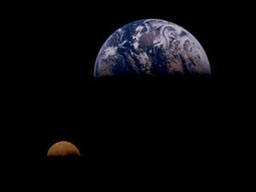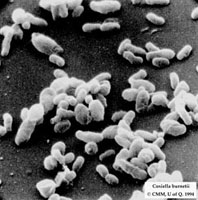




Perhaps it wasn't on Earth at all!
|
We cannot be certain where or when life began. It was a long time ago, but good detective work by earth scientists, astronomers, astrophysicists and microbiologists, amongst others, has gathered a lot of evidence that gives us some clues. These clues suggest five possibilities: |
 |
|
But to understand the meaning of these clues there is something else we will need to think about, too. |
|

If life started on Earth, then we know that it has been here for around 3.6 billion years, and possibly as long as 3.85 billion years. Micro-fossil bacteria have been found in some of the oldest rocks in the world, and they date from the later period. Some rocks, however, suggest that life is even older. It may have started just 500 million years after the Earth formed. During this primordial period the planet was undergoing severe bombardment by meteorites. Enormous chunks of rock and metal, the size of countries, were crashing into the surface of Earth at speeds as high as 35 kilometers per second (around 80,000 mph). Craters the size of Southern California, or even bigger, were formed and the energy release would have been enough to raise the surface temperature of the planet to a sustained 3,000 C (nearly 5,500 F). Additionally, at some point during this era, a planet the size of Mars collided with the proto-Earth and a double body - Earth and Moon - were formed. |
|
The immense surface temperatures must have precluded the presence of liquid water. Gradually though, from around 3.8 billion years ago, the planet cooled to a point where steam and water vapor were able to condense out of the atmosphere which, at that time, was rich in carbon-dioxide and low in oxygen. Oceans formed, but the origin of the Earth's water is uncertain. It may have come from the original materials from which the planet formed, or it may have arrived later through the visitation of comets, which are largely water ice.
|
|
|
Until recently it was speculated that the first life on Earth - probably simple bacteria - developed in the oceans, in the liquid water medium, where it was able to flourish. This idea originated from Charles Darwin who, in 1871, wrote that he imagined life originating in "... some warm little pond, with all sorts of ammonia and phosphoric salts, light, heat, electricity etc...". The idea, from such an eminent person as Darwin, was largely unquestioned for a long time and led to the theory being tested by the Miller-Urey experiment of the 1950's. The complex chemicals necessary for the formation of amino acids, and ultimately DNA, may have been created by a combination of the nutrient-rich ejecta - dust, gas and lava - of volcanic vents in the sea (ie in chemical terms - sulfur, nitrogen, calcium and phosphorus for instance) and weather energy, such as lightning and solar radiation. If this was the process, then the complex molecules of life must have been created spontaneously from these precursors. The exact process was and remains unknown. It has never been replicated in a laboratory, though some researchers claim to be close to doing it.
|
![]()

More recent ideas suggest that life started literally in the rocks of the Earth, perhaps two or three miles below the surface, where conditions were stable and the living organisms were safe from the surface conditions which were unfavorable to living organisms. Constant bombardment from the remnants of the interstellar debris that formed the Solar System was a hazard, as was the high levels of solar and cosmic radiation. Volcanic activity would also have made life difficult, with frequent re-shaping and re-forming of the surface layers. But deep down in micro-fractures in the rock, where conditions were warm and liquid water existed, maybe conditions were just right for life to evolve. Image © G Hodges
|
|
It has been suggested by researchers, such as physicist Dr Paul Davies of the University of Adelaide, that it would have been much easier for life to start on early Mars than it would have been on early Earth. Large meteorite impacts on Mars could have thrown living material into space, where it could have been carried to Earth inside small meteorites. Once here, it found favorable conditions and flourished.
While Earth and Mars are suitable candidates for this process, no other large members of the Solar System - the Giant Gas and Ice planets, for instance - seem to offer the same conditions, so it is unlikely to have occurred. However, smaller objects such as Europa in space may offer something...
|
|
|
There is growing evidence that very simple life may occur in deep space, and be riding on and inside comets. If so, the Earth may have been seeded many times with biological matter from space. Life itself may have originated, not on Earth but in deep interstellar space, five billion or more years ago. The idea was first put forward by Sir William Thomson - otherwise known as Lord Kelvin - at an address he gave to the meeting of the British Association for the Advancement of Science in Edinburgh in 1871, the same year as Darwin suggest his "warm little pool". The audience seem to have greeted the notion with polite rejection, but two famous foreign contemporaries, Herman von Helmholt and Louis Pasteur, took the ideas more seriously. Pasteur even started an examination of a meteorite that had fallen at Orgueil in France, but the results yielded nothing of interest. About a hundred years after Lord Kelvin, the idea of life in space seemed more acceptable and many scientists started to take the possibility seriously. It is now known as Panspermia. Image © NASA
|
|
|
Life may well have started in many different places at different times. This could have happened in different locations on Earth, on Earth and in space, on other planets and moons, or in primordial gas clouds deep in space, for instance. But to understand how this could be we need to think about two questions:
|
|
|
Something else to think about... If this is so, it may well have come into contact with life from an alien origin and it may even have exchanged DNA. For this to have happened though, many obviously coincidental things must have happened, which will not be elaborated here. Instead, ponder one of the most important questions that all this raises:
The questions are still open, but let us take a look at some clues by taking a look at:
|
 |
Go
to
Home
| Space Station
| Mars | Rainforest
© 1999 Satellite Events Enterprises Inc.





